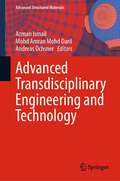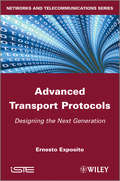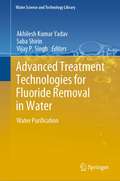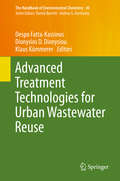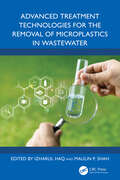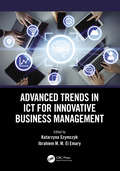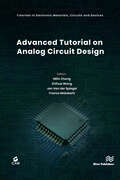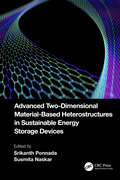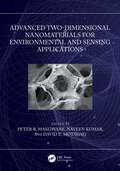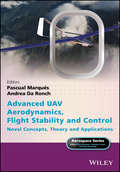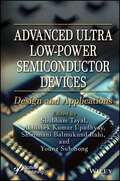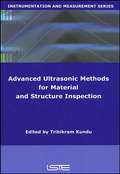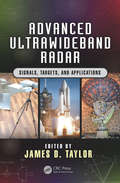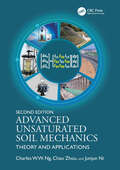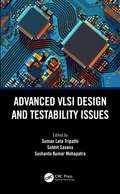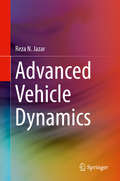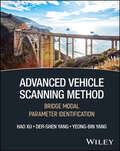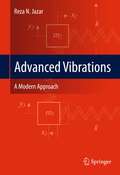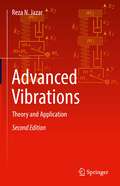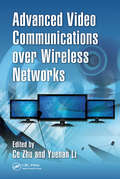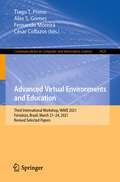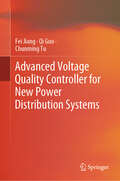- Table View
- List View
Advanced Transdisciplinary Engineering and Technology (Advanced Structured Materials #174)
by Andreas Öchsner Azman Ismail Mohd Amran Mohd DarilThis book reports research findings and outcome from various discipline of engineering and technology, focusing on industrial technology operation and sustainable development. The content is the results of research done at the Research and Innovation Section of the Universiti Kuala Lumpur – MITEC as well as several experts from other institutions in Malaysia. The content describes the latest knowledge and development aligned with current trends of industrial technology operation in Malaysia.
Advanced Transport Phenomena
by P. A. RamachandranAn integrated, modern approach to transport phenomena for graduate students, featuring traditional and contemporary examples to demonstrate the diverse practical applications of the theory. Written in an easy to follow style, the basic principles of transport phenomena, and model building are recapped in Chapters 1 and 2 before progressing logically through more advanced topics including physicochemical principles behind transport models. Treatments of numerical, analytical, and computational solutions are presented side by side, often with sample code in MATLAB, to aid students' understanding and develop their confidence in using computational skills to solve real-world problems. Learning objectives and mathematical prerequisites at the beginning of chapters orient students to what is required in the chapter, and summaries and over 400 end-of-chapter problems help them retain the key points and check their understanding. Online supplementary material including solutions to problems for instructors, supplementary reading material, sample computer codes, and case studies complete the package.
Advanced Transport Protocols: Designing the Next Generation (Wiley-iste Ser.)
by Ernesto ExpositoThe current diversity of transport services, as well as the complexity resulting from the deployment of specific transport protocols or mechanisms over the different services provided by heterogeneous networks, demand a novel design of the transport layer. Moreover, current and future applications will only be able to take advantage of the most adapted and available transport services if they are able to interact (i.e. discover, compose, deploy and adapt) efficiently with this advanced transport layer.The work presented in this book proposes a model-driven methodology and a service-oriented approach aimed at designing the mechanisms, functions, protocols and services of the next generation transport layer.The first part of this book presents the state of the art of transport protocols and introduces a model-driven methodology and an ontology semantic model implementation aimed at designing next generation transport protocols.The second part presents the UML-based design of a component-based transport protocol. An extension to this protocol based on service-component and service-oriented architectures is also presented.The third part presents various model-driven adaptive strategies aimed at managing the behavioral and structural adaptation of next generation autonomic transport protocols.The fourth and final part presents the design of a transport layer based on component-oriented and service-oriented approaches and integrating the autonomic computing paradigm guided by the semantic dimension provided by ontologies.
Advanced Transport Systems: Analysis, Modeling, and Evaluation of Performances
by Milan JanićThis book provides a systematic analysis, modeling and evaluation of the performance of advanced transport systems. It offers an innovative approach by presenting a multidimensional examination of the performance of advanced transport systems and transport modes, useful for both theoretical and practical purposes. Advanced transport systems for the twenty-first century are characterized by the superiority of one or several of their infrastructural, technical/technological, operational, economic, environmental, social and policy performances as compared to their conventional counterparts. The advanced transport systems considered include: Bus Rapid Transit (BRT) and Personal Rapid Transit (PRT) systems in urban area(s), electric and fuel cell passenger cars, high speed tilting trains, High Speed Rail (HSR), Trans Rapid Maglev (TRM), Evacuated Tube Transport system (ETT), advanced commercial subsonic and Supersonic Transport Aircraft (STA), conventionally- and Liquid Hydrogen (LH2)-fuelled commercial air transportation, advanced Air Traffic Control (ATC) technologies and procedures for increasing the airport runway capacity, Underground Freight Transport (UFT) systems in urban area(s), Long Intermodal Freight Train(s) (LIFTs), road mega trucks, large advanced container ships and freight/cargo aircraft and advanced freight/goods collection distribution networks. This book is intended for postgraduates, researchers, professionals and policy makers working in the transport industry.
Advanced Treatment Technologies for Fluoride Removal in Water: Water Purification (Water Science and Technology Library #125)
by Vijay P. Singh Akhilesh Kumar Yadav Saba ShirinThis book presents an overview of the techniques available today for the removal of fluoride contamination/pollutants/species from water. Also covered are traditionally applied techniques for the removal of fluoride pollutants/species, including oxidation, coagulation-flocculation, and membrane techniques. Recently, progress has been made on the utility of various nanoparticles for the extraction of contaminants from water. Fluoride contamination is affecting water resources quality worldwide as a result of human activities, such as mining and pesticide use. Due to the high risk of fluoride exposure, specific water treatment processes are required to meet more severe water quality standards. A better understanding of currently available processes is necessary to develop economical, efficient, and effective methods for fluoride removal. Fluoride can either be coated, adsorbed using a wide range of both mineral and organic constituents or can be directly rejected by membrane processes, such as reverse osmosis and nanofiltration. Recent developments of submerged hybrid membrane systems, such as membrane bioreactors in wastewater treatment, provide alternative technologies for fluoride treatment.
Advanced Treatment Technologies for Urban Wastewater Reuse (The Handbook of Environmental Chemistry #45)
by Klaus Kümmerer Despo Fatta-Kassinos Dionysios D. DionysiouThis volume offers a detailed overview of currently applied and testedwastewater treatment technologies and the integration of advanced processes toremove trace organic contaminants and microorganisms. It discusses thepotential of enhanced biological treatment to produce effluent suitable forreuse, new processes for urban wastewater disinfection and the reduction ofantibiotic resistant bacteria, as well as the effect of advanced oxidationprocesses on wastewater microbiome and chemical contaminants. It also presentsmembrane bioreactors, moving bed bioreactors, light and solar driven technologies,ozonation and immobilised heterogeneous photocatalysis and provides an evaluationof the potential of constructed wetlands integrated with advanced oxidationtechnologies to produce wastewater safe for reuse. Furthermore, the volumediscusses water reuse issues and standards, the status of membrane bioreactorsapplications, and the treatment of reverse osmosis concentrate for enhancedwater recovery during wastewater treatment. Finally, it presents recentdevelopments in potable water reuse and addresses various important issues inthis framework, like the proper protection of public health, reliability andmonitoring. This volume is of interest to experts, scientists and practitionersfrom various fields of research, includinganalytical and environmental chemistry, toxicology and environmental and sanitaryengineering, as well as treatment plant operators and policymakers.
Advanced Treatment Technologies for the Removal of Microplastics in Wastewater
by Maulin P. Shah Izharul HaqMicroplastics have become a significant environmental concern due to their persistence, potential to accumulate in aquatic ecosystems, and ability to infiltrate the food chain. Given the limitations of conventional wastewater treatment processes, advanced treatment technologies are being developed to enhance microplastic removal and mitigate their environmental impact. Advanced Treatment Technologies for the Removal of Microplastics in Wastewater presents the pervasive issue of microplastic pollution in wastewater, examining its origins in everyday activities and industrial processes and its spread through aquatic ecosystems. This book provides a deep dive into advanced treatment technologies including physico-chemical and biological methods, highlighting both the progress and challenges in effectively removing microplastics from wastewater. It also addresses the potential health risks posed by microplastic exposure, discussing how these particles act as carriers for toxic substances and their suspected links to health issues in humans and wildlife. With cutting-edge research, practical insights, and a comprehensive overview, this book equips readers with the knowledge needed to understand and address the critical issue of microplastics in our water and wastewater systems. Provides updated occurrence and characteristics of microplastics in various industrial wastewaters Presents advanced wastewater treatment technologies for microplastics removal. Gives a detailed account of the toxic effects of microplastics on animals, plants, and humans Covers innovative approaches for the management of emerging toxic compounds in industrial wastewaters.
Advanced Trends in ICT for Innovative Business Management
by Ibrahiem M. M. El Emary Katarzyna SzymczykThis book contains a collection of scientific chapters addressing the emerging trends in IT and telecommunications, as well as the issues that accompany them in business. It addresses issues in cyber applications, ICT solutions and innovative cyber know-how, and demonstrates how high-tech IT communications resources can be used to improve business production, sales and service strategies, supply chains and logistics. The book is based on articles from ICCMIT’20, extending their approach to specific chapters. The chapters cover issues such as financial management, technological upgrades, Industry 4.0 and the trend towards sustainable development. It utilizes examples of technologically advanced enterprises developing under Industry 4.0 assumptions at the stage of digital transformation, which integrate digital technologies and business processes. In addition, this book discusses issues related to cyber risk management and the implementation of a number of safeguards for digitized enterprises. Enterprises that orient themselves towards technological innovations find that they can reach customers faster, are more effectively managed and can achieve a competitive advantage over other businesses. This book will be a great aid to professionals in such companies, both in IT departments and in the management team.
Advanced Tutorial on Analog Circuit Design
by Franco Maloberti Zhihua Wang Jan Van der Spiegel Milin ZhangThis book is a summary of analog circuit design related lectures from IEEE Advanced CMOS Technology School (ACTS) 2019. The topics cover continuous-time delta-sigma data converter, switched-capacitor power converter, ADC and power management IC. The slides are selected from the handouts, while the text was edited according to the lecturers talk. ACTS is a joint activity supported by the IEEE Circuit and System Society (CASS) and the IEEE Solid-State Circuits Society (SSCS). The goal of the school is to provide society members as well researchers and engineers from industry the opportunity to learn about new emerging areas from leading experts in the field. ACTS is an example of high-level continuous education for junior engineers, teachers in academe, and students. ACTS was the results of a successful collaboration between societies, the local chapter leaders, and industry leaders.
Advanced Two-Dimensional Material-Based Heterostructures in Sustainable Energy Storage Devices
by Susmita Naskar Srikanth PonnadaAdvanced Two-Dimensional Material-Based Heterostructures in Sustainable Energy Storage Devices provides a detailed overview of advances and challenges in the development of 2D materials for use in energy storage devices. It offers deep insight into the synthesis, characterization, and application of different 2D materials and their heterostructures in a variety of energy storage devices, focusing on new phenomena and enhanced electrochemistry.This book: Introduces 2D materials, synthesis methods, and characterization techniques Discusses application in a wide range of batteries and supercapacitors Offers perspectives on future investigations necessary to overcome existing challenges This comprehensive reference is written to guide researchers and engineers working to advance the technology of energy-efficient energy storage devices.
Advanced Two-Dimensional Nanomaterials for Environmental and Sensing Applications
by Naveen Kumar Peter R. Makgwane David E. MotaungAdvanced Two-Dimensional Nanomaterials for Environmental and Sensing Applications provides state-of-the-art progress developments in the design strategies of 2D-based nanomaterials. It covers specific focused applications in respective environmental challenges posed by pollutants such as chemical gases, bacterial and microbial, textile dyes, pharmaceutical antibiotics, agricultural pesticides, and toxic heavy metals in water and air contaminations. It elaborates the applications of 2D nanomaterials in the context of technologies such as sensing and detection to monitor pollutants, as well as photocatalysis and adsorption for the removal of pollutants.Features: Elaborates the applications of 2D nanomaterials in the context of sensing and detection to monitor pollutants, as well as photocatalysis and adsorption for the removal of pollutants. Focuses on environmental pollutants detection, removal or remediation, and monitoring device fabrications. Discusses materials of specific dimension (2D). Covers both water and air remediation. Includes photocatalytic degradations and antimicrobial disinfection. This book is aimed at graduate students and researchers in chemical and civil engineering, materials science, and nanomaterials.
Advanced UAV Aerodynamics, Flight Stability and Control: Novel Concepts, Theory and Applications
by Andrea Da Ronch Pascual MarquésComprehensively covers emerging aerospace technologies Advanced UAV aerodynamics, flight stability and control: Novel concepts, theory and applications presents emerging aerospace technologies in the rapidly growing field of unmanned aircraft engineering. Leading scientists, researchers and inventors describe the findings and innovations accomplished in current research programs and industry applications throughout the world. Topics included cover a wide range of new aerodynamics concepts and their applications for real world fixed-wing (airplanes), rotary wing (helicopter) and quad-rotor aircraft. The book begins with two introductory chapters that address fundamental principles of aerodynamics and flight stability and form a knowledge base for the student of Aerospace Engineering. The book then covers aerodynamics of fixed wing, rotary wing and hybrid unmanned aircraft, before introducing aspects of aircraft flight stability and control. Key features: Sound technical level and inclusion of high-quality experimental and numerical data. Direct application of the aerodynamic technologies and flight stability and control principles described in the book in the development of real-world novel unmanned aircraft concepts. Written by world-class academics, engineers, researchers and inventors from prestigious institutions and industry. The book provides up-to-date information in the field of Aerospace Engineering for university students and lecturers, aerodynamics researchers, aerospace engineers, aircraft designers and manufacturers.
Advanced Ultra Low-Power Semiconductor Devices: Design and Applications
by Shubham Tayal Shiromani Balmukund Rahi Abhishek Kumar Upadhyay Young Suh SongADVANCED ULTRA LOW-POWER SEMICONDUCTOR DEVICES Written and edited by a team of experts in the field, this important new volume broadly covers the design and applications of metal oxide semiconductor field effect transistors. This outstanding new volume offers a comprehensive overview of cutting-edge semiconductor components tailored for ultra-low power applications. These components, pivotal to the foundation of electronic devices, play a central role in shaping the landscape of electronics. With a focus on emerging low-power electronic devices and their application across domains like wireless communication, biosensing, and circuits, this book presents an invaluable resource for understanding this dynamic field. Bringing together experts and researchers from various facets of the VLSI domain, the book addresses the challenges posed by advanced low-power devices. This collaborative effort aims to propel engineering innovations and refine the practical implementation of these technologies. Specific chapters delve into intricate topics such as Tunnel FET, negative capacitance FET device circuits, and advanced FETs tailored for diverse circuit applications. Beyond device-centric discussions, the book delves into the design intricacies of low-power memory systems, the fascinating realm of neuromorphic computing, and the pivotal issue of thermal reliability. Authors provide a robust foundation in device physics and circuitry while also exploring novel materials and architectures like transistors built on pioneering channel/dielectric materials. This exploration is driven by the need to achieve both minimal power consumption and ultra-fast switching speeds, meeting the relentless demands of the semiconductor industry. The book’s scope encompasses concepts like MOSFET, FinFET, GAA MOSFET, the 5-nm and 7-nm technology nodes, NCFET, ferroelectric materials, subthreshold swing, high-k materials, as well as advanced and emerging materials pivotal for the semiconductor industry’s future.
Advanced Ultrasonic Methods for Material and Structure Inspection (Instrumentation And Meassurement Ser.)
by Dominique PlackoUltrasonic signals are increasingly being used for predicting material behavior, both in an engineering context (detecting anomalies in a variety of structures) and a biological context (examining human bones, body parts and unborn fetuses). Featuring contributions from authors who are specialists in their subject area, this book presents new developments in ultrasonic research in both these areas, including ultrasonic NDE and other areas which go beyond traditional imaging techniques of internal defects. As such, both those in the biological and physical science communities will find this an informative and stimulating read.
Advanced Ultrawideband Radar: Signals, Targets, and Applications (Force Drawing Series)
by James D. TaylorThis book presents the latest theory, developments, and applications related to high resolution materials-penetrating sensor systems. An international team of expert researchers explains the problems and solutions for developing new techniques and applications. Subject areas include ultrawideband (UWB) signals propagation and scattering, materials-penetrating radar techniques for small object detection and imaging, biolocation using holographic techniques, tomography, medical applications, nondestructive testing methods, electronic warfare principles, through-the-wall radar propagation effects, and target identification through measuring the target return signal spectrum changes.
Advanced Unsaturated Soil Mechanics: Theory and Applications
by Junjun Ni Charles W.W. Ng Chao ZhouUnsaturated soil is a three-phase material that is ubiquitous on the Earth’s surface and exhibits complex behaviour, which becomes more complex in response to the Earth’s changing climate and increasing engineering activities. This is because the former affects its moisture and temperature conditions significantly and the latter governs its stress state and suction condition. This book is designed to meet the increasing challenges of climate change and engineering activities by covering the mechanics and engineering of unsaturated soil in a logical manner. It comprises four major parts: Water retention and flow characteristics Shear strength and stiffness at various temperatures State-dependent elasto-plastic constitutive modelling Field monitoring and engineering applications This second edition uniquely covers fundamental topics on unsaturated soil that are not covered in other similar books, including: the state- dependency of soil- water retention behaviour and water permeability functions, such as dependence on engineering activities small strain stiffness considering the influence of wetting- drying cycles and recent suction history, such as that due to climate change suction effects on dilatancy and peak shear strength cyclic thermal effects on soil behaviour state- dependent elastoplastic constitutive modelling of monotonic and cyclic behaviour engineering applications such as the South-to-North Water Transfer Project; an earthen landfill cover system devoid of geomembrane in the Xiaping landfill, Shenzhen; and a 15-m-deep multi- propped excavation in Tianjin, China
Advanced VLSI Design and Testability Issues
by Suman Lata Tripathi Sobhit Saxena S. K. MohapatraThis book facilitates the VLSI-interested individuals with not only in-depth knowledge, but also the broad aspects of it by explaining its applications in different fields, including image processing and biomedical. The deep understanding of basic concepts gives you the power to develop a new application aspect, which is very well taken care of in this book by using simple language in explaining the concepts. In the VLSI world, the importance of hardware description languages cannot be ignored, as the designing of such dense and complex circuits is not possible without them. Both Verilog and VHDL languages are used here for designing. The current needs of high-performance integrated circuits (ICs) including low power devices and new emerging materials, which can play a very important role in achieving new functionalities, are the most interesting part of the book. The testing of VLSI circuits becomes more crucial than the designing of the circuits in this nanometer technology era. The role of fault simulation algorithms is very well explained, and its implementation using Verilog is the key aspect of this book. This book is well organized into 20 chapters. Chapter 1 emphasizes on uses of FPGA on various image processing and biomedical applications. Then, the descriptions enlighten the basic understanding of digital design from the perspective of HDL in Chapters 2–5. The performance enhancement with alternate material or geometry for silicon-based FET designs is focused in Chapters 6 and 7. Chapters 8 and 9 describe the study of bimolecular interactions with biosensing FETs. Chapters 10–13 deal with advanced FET structures available in various shapes, materials such as nanowire, HFET, and their comparison in terms of device performance metrics calculation. Chapters 14–18 describe different application-specific VLSI design techniques and challenges for analog and digital circuit designs. Chapter 19 explains the VLSI testability issues with the description of simulation and its categorization into logic and fault simulation for test pattern generation using Verilog HDL. Chapter 20 deals with a secured VLSI design with hardware obfuscation by hiding the IC’s structure and function, which makes it much more difficult to reverse engineer.
Advanced Vehicle Dynamics
by Reza N. JazarThis book covers the principles and applications of vehicle handling dynamics from an advanced perspective in depth. The methods required to analyze and optimize vehicle handling dynamics are presented, including tire compound dynamics, vehicle planar dynamics, vehicle roll dynamics, full vehicle dynamics, and in-wheel motor vehicle dynamics. The provided vehicle dynamic model is capable of investigating drift, sliding, and other over-limit vehicle maneuvers. This is an ideal book for postgraduate and research students and engineers in mechanical, automotive, transportation, and ground vehicle engineering.
Advanced Vehicle Scanning Method: Bridge Modal Parameter Identification
by Hao Xu Yeong-Bin Yang Der-Shen YangFramework for scanning modal parameters of bridges from vehicle responses utilizing the Vehicle Scanning Method (VSM) Advanced Vehicle Scanning Method: Bridge Modal Parameter Identification delivers a complete theoretical framework for scanning of the modal parameters (frequencies, damping ratios, and mode shapes) of bridges from vehicle responses. This book provides comprehensive coverage of the application of the Vehicle Scanning Method (VSM) for different types of bridges, which has the advantage of mobility, economy, and efficiency over the conventional, direct method. Most of the materials presented in each chapter have been published as technical papers in high-ranking international journals, which were subjected to critical reviews. The contents of the book have been arranged such that they are reflective of the progressive advancement of the VSM technique. Edited by a highly qualified team of authors including one of the original developers of the VSM technique, Advanced Vehicle Scanning Method includes information on: The theoretical basis for bridge frequency identification and scanning methods enhanced by software and hardware toolsThe damping formula for determining the bridge damping ratio from the spatial correlation of the front and rear wheels of a two-axle test vehicleThe methods for removing the damping distortion effect on bridge mode shape recovery with no prior knowledge of bridge damping ratiosThe theoretical basis of scanning frequencies, damping ratios, and mode shapes using VSM for various types of bridges, such as curved bridges and thin-walled girders Advanced Vehicle Scanning Method is an essential reference on the subject for researchers working on bridge dynamics, graduate students in programs of study related to vehicle-bridge interaction, and practicing bridge engineers.
Advanced Vibration Analysis
by S. Graham KellyDelineating a comprehensive theory, Advanced Vibration Analysis provides the bedrock for building a general mathematical framework for the analysis of a model of a physical system undergoing vibration. The book illustrates how the physics of a problem is used to develop a more specific framework for the analysis of that problem. The author elucidat
Advanced Vibrations: A Modern Approach
by Reza N. JazarAdvanced Vibrations: A Modern Approach is presented at a theoretical-practical level and explains mechanical vibrations concepts in detail, concentrating on their practical use. Related theorems and formal proofs are provided, as are real-life applications. Students, researchers and practicing engineers alike will appreciate the user-friendly presentation of a wealth of topics including but not limited to practical optimization for designing vibration isolators, and transient, harmonic and random excitations.
Advanced Vibrations: Theory and Application
by Reza N. JazarNow in an updated new edition, this textbook explains mechanical vibrations concepts in detail, concentrating on their practical use. This second edition includes the new chapter Multi-Degree-of-Freedom (MDOF) Time Response, as well as new sections covering superposition, music and vibrations, generalized coordinates and degrees-of-freedom, and first-order systems. Related theorems and formal proofs are provided, as are real-life applications. Students, researchers, and practicing engineers alike will appreciate the user-friendly presentation of a wealth of topics, including practical optimization for designing vibration isolators and transient and harmonic excitations. Advanced Vibrations: Theory and Application is an ideal text for students of engineering, designers, and practicing engineers.
Advanced Video Communications over Wireless Networks
by Ce Zhu Yuenan LiWireless video communications encompass a broad range of issues and opportunities that serve as the catalyst for technical innovations. To disseminate the most recent advances in this challenging yet exciting field, Advanced Video Communications over Wireless Networks provides an in-depth look at the fundamentals, recent technical achievements, challenges, and emerging trends in mobile and wireless video communications. The editors have carefully selected a panel of researchers with expertise in diverse aspects of wireless video communication to cover a wide spectrum of topics, including the underlying theoretical fundamentals associated with wireless video communications, the transmission schemes tailored to mobile and wireless networks, quality metrics, the architectures of practical systems, as well as some novel directions. They address future directions, including Quality-of-Experience in wireless video communications, video communications over future networks, and 3D video communications. The book presents a collection of tutorials, surveys, and original contributions, providing an up-to-date, accessible reference for further development of research and applications in mobile and wireless video communication systems. The range of coverage and depth of expertise make this book the go-to resource for facing current and future challenges in this field.
Advanced Virtual Environments and Education: Third International Workshop, WAVE 2021, Fortaleza, Brazil, March 21–24, 2021, Revised Selected Papers (Communications in Computer and Information Science #1425)
by Fernando Moreira Tiago T. Primo Alex S. Gomes César CollazosThis volume revised versions of the selected papers presented during the Third International Workshop on Advanced Virtual Environments and Education, WAVE 2021, held in Fortaleza, Brazil, in March 2021. The 7 full papers and 4 short papers presented were thoroughly reviewed and selected from the 27 submissions. The papers are organized in the following topical sections: learning scenarios and grouping methods; applications and scenarios, phigital, CS education and assessment; human computer interfaces for education, study cases for accessibility and wellbeing.
Advanced Voltage Quality Controller for New Power Distribution Systems
by Fei Jiang Qi Guo Chunming TuThis book focuses on the urgent demand for high-quality and efficient development of active distribution networks, which aims to address the bottleneck issues such as single functionality, low equipment utilization, and poor reliability encountered in the practical process of the commercialization of series-connected voltage-quality controllers. The book primarily conducts research on the expansion of functions and performance improvement of series-connected voltage-quality controllers, which summarizes some achievements and experiences of the authors in the new topology, new technology, new methods, and engineering application cases of advanced series-connected voltage-quality controllers. This book serves as a guidelines for scholars, students, engineers, and equipment manufacturers in the fields of power electronics technology and advanced power quality control technology.
